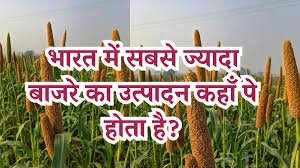Largest Millet-Producing Indian State: Key Insights and Significance
Introduction to India’s Millet Production
India has long been a significant producer of millet, a nutritious and resilient crop that plays a vital role in the agricultural economy. With increasing recognition of millets for their health benefits, especially in combating malnutrition, India is witnessing a renewed focus on millet production. Among all the states, the largest producer of millet is Rajasthan, a state known for its arid conditions and vast agricultural expanse.
Rajasthan: The Leading Millet Producer
Rajasthan has emerged as the largest producer of millets in India. The state produces a wide variety of millets, including pearl millet (bajra), finger millet (ragi), and sorghum. Millet farming in Rajasthan is supported by the state’s favorable agro-climatic conditions, which make it ideal for growing these hardy crops. The production of millet contributes significantly to the state’s agricultural output, supporting both local consumption and export.
The Rajasthan government has been promoting millet cultivation through various schemes and programs, including financial support and technological assistance, to encourage farmers to grow millets. These efforts aim to boost the state’s agricultural diversity while addressing issues of food security and climate resilience.

Why This News Is Important
Economic Impact on Indian Agriculture
The recognition of Rajasthan as the largest millet producer has significant economic implications for India’s agricultural sector. As a drought-resistant crop, millet is crucial in regions like Rajasthan, where water scarcity is a recurring challenge. By focusing on millet production, the state contributes to the national effort to diversify food production while ensuring food security in areas vulnerable to climate change. Additionally, millet farming provides economic stability to farmers by offering a crop that requires fewer resources to grow.
Health and Nutrition Benefits
Millets are packed with essential nutrients such as fiber, protein, vitamins, and minerals, making them an ideal food source to combat malnutrition in India. Millets are also gluten-free, making them an excellent option for people with gluten intolerance. Promoting millet production in states like Rajasthan aligns with India’s push towards improving the nutritional quality of food available to its population.
Supporting India’s Sustainable Development Goals (SDGs)
The promotion of millet cultivation contributes to India’s sustainable development goals, particularly in the areas of eradicating hunger, promoting sustainable agriculture, and ensuring good health and well-being. Millets have a lower environmental footprint compared to other cereal crops, making their promotion a step towards sustainable agricultural practices.
Historical Context: Millets in India’s Agricultural Landscape
Millets have been cultivated in India for thousands of years, dating back to ancient times when they were a staple in the Indian diet. However, with the advent of green revolution crops like rice and wheat, millet cultivation declined due to their lower yield and higher labor demands.
In recent years, there has been a resurgence of interest in millets, driven by their nutritional value and resilience in the face of climate change. In 2023, the United Nations declared the year as the “International Year of Millets,” a global effort to highlight the importance of millets for food security, nutrition, and climate resilience.
In India, government initiatives such as the National Food Security Mission (NFSM) and state-level policies have been encouraging farmers to return to millet cultivation. Rajasthan, with its vast drylands and advanced agricultural practices, has played a pivotal role in this movement, positioning itself as the country’s leading millet producer.
Key Takeaways from “Largest Millet-Producing Indian State”
| S.No. | Key Takeaway |
|---|---|
| 1 | Rajasthan is the largest producer of millets in India. |
| 2 | Millets are climate-resilient crops ideal for drought-prone areas. |
| 3 | The state produces a variety of millets, including bajra and ragi. |
| 4 | Millets are nutritious and offer numerous health benefits. |
| 5 | Rajasthan’s promotion of millet farming supports India’s SDGs. |
Important FAQs for Students from this News
1. Which state is the largest producer of millets in India?
- Answer: Rajasthan is the largest producer of millets in India, particularly known for producing varieties like pearl millet (bajra), finger millet (ragi), and sorghum.
2. Why is millet farming important in Rajasthan?
- Answer: Millet farming is crucial in Rajasthan due to the state’s arid conditions. Millets are drought-resistant and require fewer resources, making them ideal for regions prone to water scarcity.
3. What are the nutritional benefits of millets?
- Answer: Millets are rich in essential nutrients such as fiber, protein, vitamins, and minerals. They are also gluten-free, making them a healthy option for people with gluten intolerance.
4. How does millet production contribute to India’s sustainable development?
- Answer: Millet cultivation supports India’s sustainable development goals by promoting climate-resilient agriculture, improving food security, and contributing to better health and nutrition.
5. What are the government initiatives promoting millet farming in India?
- Answer: Government programs like the National Food Security Mission (NFSM) and state-level initiatives in Rajasthan encourage the cultivation of millets, which helps in ensuring food security and enhancing nutritional intake.
6. Why was 2023 declared the International Year of Millets?
- Answer: The United Nations declared 2023 as the International Year of Millets to highlight their importance in addressing global food security, climate resilience, and nutrition.
Some Important Current Affairs Links















